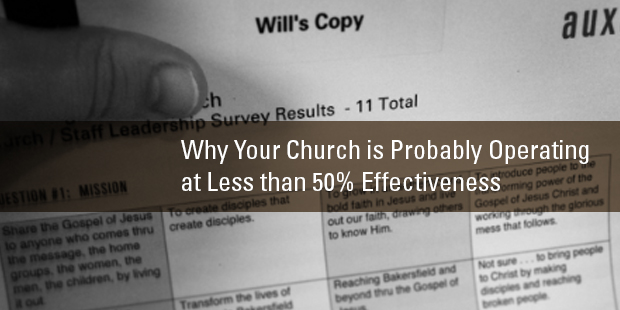
Why Your Church is Probably Operating at Less Than 50% Effectiveness
Most of you will disagree with what I am about to suggest. Nevertheless, I will try my best to share with you what I’ve learned over the last 13 years. Keep in mind that this post title is not a theory; it comes from a front row seat watching real transformation of senior pastors, their staff, their lay leaders, and eventually their entire congregation.
First, I’ll share the problem and give some quick illustrations of churches in the transformation process. Secondly, I will give two analogies to reinforce my point.
THE PROBLEM
The problem is that most churches have a general sense of their mission rather than clearly defined and contextually crafted mission. What does it mean to be working with a general sense of mission? Let’s illustrate. I just surveyed the top 10 staff at a large church (and by most standards a successful church) running over 1,000 in weekend attendance. When asked to state their mission, the answers included:
- Extending the joy of following Christ to all people
- To make disciples and serve the community
- Reach people and growing disciples
- Being God’s agent in world to make a difference in the world, everywhere we go.
- To provide worship, small group and service opportunities
These statements of mission illustrate “leading from a general sense” for two reasons. First, they are not articulating the same words. Second, they are general re-articulations of the great commission. Any nuance among them is due to the bias and experience of the individual. One sounds operational while another sounds missional. One is a follower of John Piper, and one just read, “The Externally Focused Church.” You get the idea.
Now, some may object and suggest that these generic restatements aren’t a problem at all. Isn’t having a general orientation toward a disciple-making mission enough? I don’t think so.
REAL MISSION
In the last 4 years, I have worked with three churches all within a 10 minutes drive from one another in Dallas, Texas. All of these churches run over 1,000 in weekend attendance. Below is the new articulated mission of each church. Keep in mind that when I started working with them, the key leaders only had a general sense of mission.
Church #1: Inviting people into the unexpected joy of desperate dependence on Jesus.
Church #2: Rescuing one another from cultural Christianity to follow Jesus every day.
Church #3: Calling the Christian-ish to become passionate servants of Christ.
Each one of these churches has a mission that reflects:
- Aspects of denominational heritage (Bible, Baptist & Methodist, respectively)
- Clues to their corporate strengths and passion as a congregation
- Nuances guided by their location and facility assets within Dallas
- An outward posture based on engaging the Dallas culture
Last week I had a follow-up visit with two of the churches. Here are exact quotes from their staff:
- “We are not the same church we used to be.”
- “Everyone in our church ‘gets it.’ They know who we are and what we are about, and this creates powerful synergy.”
- “As a result of our focus with leaders in the body, we gave $550,000 more than we ever have to a one-time missions offering (50% increase in giving).”
- “Our greatest challenge is a willing readiness of our people to do more!”
More energy. Greater resources. Better synergy. Would you like to have that right now at your church? Sure you would. Would you have guessed that the first step toward this “more” is defining for the first time what your specific mission is as a church? Probably not. And that’s my point. As a result of your generic mission you are most likely operating at less than 50% of what you could be. If you don’t know your mission, you certainly don’t have a culture of mission. And if you don’t have a culture of mission, than what are people in your church really doing? Why are they there?
TWO ANALOGIES
The first analogy is a restaurant start-up. Imagine that we were excited to start a new restaurant and believed it had the potential to be a successful franchise. To get off the ground we want to attract investors and a few talented people to join our ambitious dream. How successful do you think we would be if our mission were to “make food and serve the community?” You guessed it— not very. Why? The language of mission does nothing to differentiate us from the thousands of restaurants that already exist. Nor does it guide our thinking, synergy, planning and communication for practical next steps. We really need to decide whether we are a fast-casual Italian or fine-dining seafood? Right!?
Consider another very different example. My wife Romy is a very talented artist. Sometimes she paints a random scene or an image that inspired her. Sometime she paints with a purpose, selecting a pre-determined location for a painting with a specific objective that guides the content, color and emotion of the work. What might look like the same act to an unknowing observer—Romy painting two similar paintings—is actually very different. One painting requires no pre-thought or preparation. The other work of art is very calculated; she paints with a completely intensity and focus. Purpose changes everything!
So now it’s up to you. If this post means anything to you, conduct a litmus test: do your people know your mission? Is it meaningfully articulated based on your understanding of what your church can do better than 10,000 others? If not, then I think you are operating at a capacity less than 50% of what you should be. And that’s not an exaggeration. And, if you want to talk about it just let me know in the comments below.
If you already do run with a clear, concise, compelling and contextual mission, I would love to know about it and share it with the world. Let me know your mission in the comments section below.
Life if short and ministry is hard. So let’s lead with stunning clarity!
Read more from Will here.
Would you like to learn more about leading with stunning clarity? Connect with an Auxano Navigator and start a conversation with our team.

































